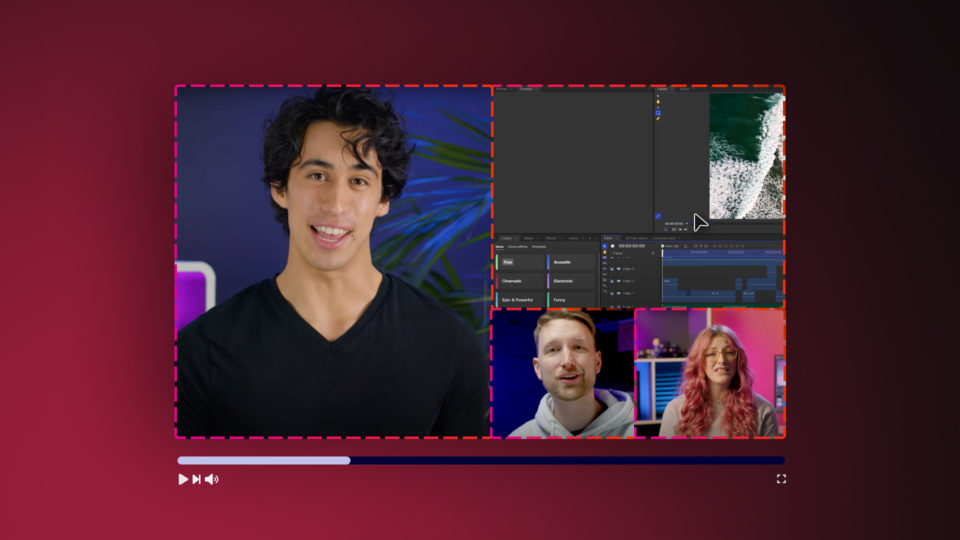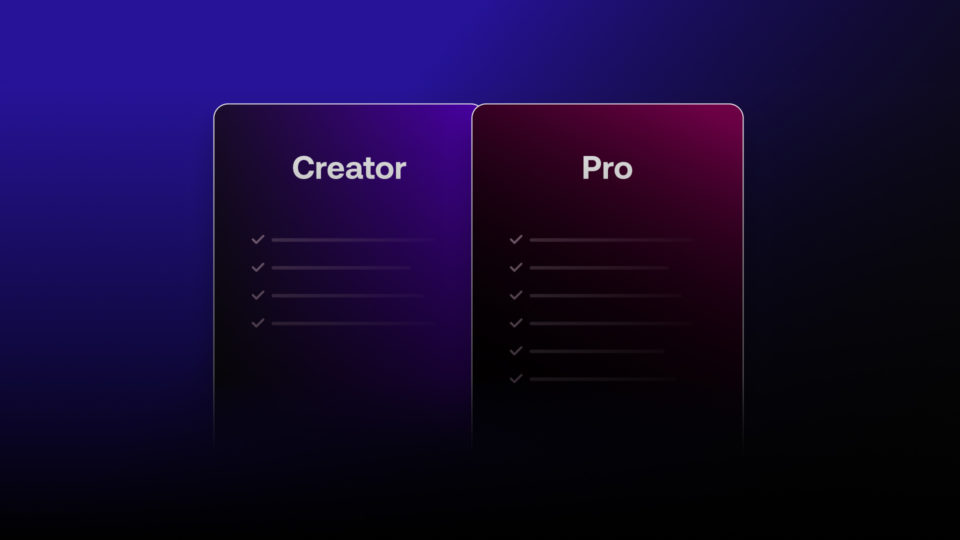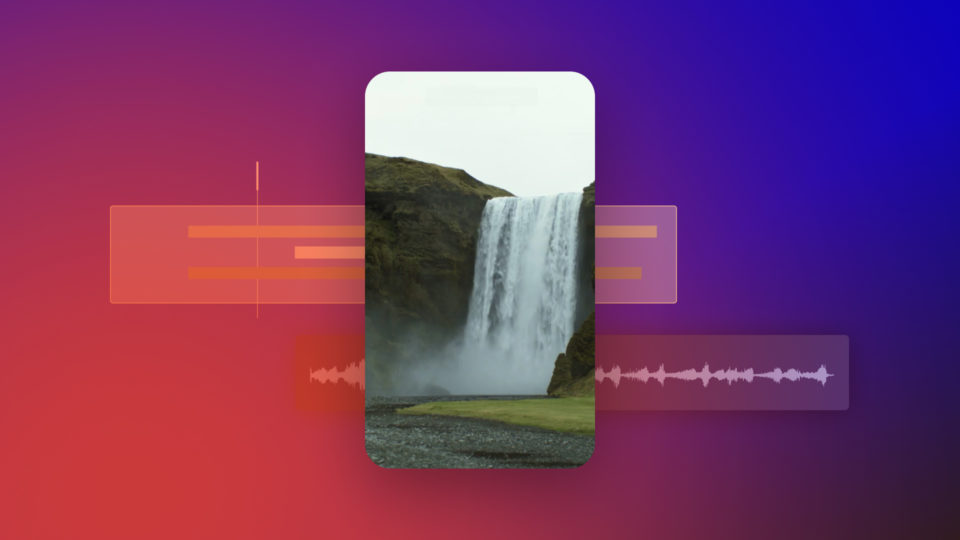Today’s update is a big one. We’ve got particle performance boosts, new camera controls, new auto-alignment and extensive new performance management tools. Grab the download and then read on, because we’ve made a lot of changes.
3D camera controls
The way HitFilm’s camera works hasn’t changed since version 1 and we’ve wanted to give it an overhaul for some time. Update #3 adds new features and rethinks the interface.
In the Viewer you’ll spot a new camera control at the top-right of each view. This is the Zoom control, providing a quick way to adjust zoom without needing to dig into the Controls panel.
Less obvious is the new Orbit tool. Of course, there’s always been an orbit tool but it’s now got two modes which you can switch between by holding down on the button.
Orbit around clicked point is the mode that’s always been in HitFilm, drawing a line from the mouse pointer into 3D space and orbiting around that point. This is a fast, convenient way to move around but in complex 3D scenes can become unpredictable.
That’s why we’ve introduced Orbit around select layer, which locks the orbit to the currently selected 3D layer. This means you can specify precisely what you want to orbit around by first selecting it in the Viewer or on the timeline. If you don’t have a layer selected you’ll orbit around the center of the scene instead.
We’ve redesigned all the camera shortcuts. Here’s how they’re now laid out:
- Orbit: Alt+Left mouse
- Dolly: Alt+Right mouse
- Zoom: Ctrl+Right mouse
- Rotate: Middle mouse
- Pan: Right mouse (perspective + orthographic views only), Alt+Middle mouse or Ctrl+Left mouse
- Canvas pan: Right mouse (active camera view only)
- Select object: Left mouse
You can also hold Shift during a pan to lock to either the vertical or horizontal axis. Note that on Macs, you should use the Cmd key instead of Ctrl.
New targeting controls
There’s a comprehensive new targeting and alignment system available to 3D layers. This means you can automatically have a 3D layer face another 3D layer, even as either or both of them are in motion.
This system extends to the targeting of spotlights and cameras as well as to the focal point of cameras, which opens up intriguing new animation possibilities and will save you a massive amount of time going forward. No more guessing about position properties or wondering whether your layer is in sharp focus.
Where this gets super powerful is in the targeting of layers towards points. This means you can set a camera’s aim and focus to a specific spot on a 3D model, without needing to do any hand animation. You can link a spotlight to the same area, and have it all work automatically even while the camera and/or 3D model move around in the scene.
Performance vs quality
On the Project screen you’ll find two new options, sitting just below the Reflection Map Size. You can now set the map size for shadows and 3D model textures.
Adjusting the reflection and shadow maps will affect their rendering quality. Previously we defaulted to 2048 pixels which in most scenarios is sufficient, but you can now ramp it up higher if your GPU can handle it or even drop it down if you don’t need precision.
The 3D model cap makes it nice and easy to work with texture-heavy models even if your graphics card is struggling. If you wanted to use a model that had a bunch of 6K textures on an ordinary GPU you used to have to manually resize them in Photoshop, but you can now get HitFilm to automatically downscale all textures to 2K or 4K. And even if your fancy computer rig can handle hundreds of gigantic textures, this now gives you the option of dropping everything down to high performing 512 pixel res textures while setting up your scene, before reverting to full quality prior to exporting.
As well as the new custom map sizes we’ve also upgraded the Viewer quality menu, which previously only worked on 2D effects. It now also scales 3D texture maps accordingly, so if you’re using 4K textures on a model you can drop them down to 1024 pixel resolution simply by changing the Viewer quality. This makes it possible to keep all your lighting and rendering options turned on in the Viewer while maintaining real time performance even in complex scene, which is great news for animators.
This is all about giving advanced users control over how HitFilm performs, rather than hiding these options away behind-the-scenes. You can now fine tune your experience depending on your own preferences and the needs of the project.
The big list
Update #3 has a lot more going on, including improvements to particle layer emitter performance. Here’s the full list of changes:
Features
- Light, Camera and Asset Layers can now be aligned in Layer Properties to automatically face another layer
- Cameras can now use another layer to set the focal distance
- New option for limiting the Maximum 3D Model Map Size on the Project screen
- New option for adjusting the Shadow Map Size on the Project screen
- Using the Viewer quality downsampling options now provides a bigger performance boost when the scene includes 3D models
- Added a new tool in the Viewer to control the camera zoom
- New Orbit mode for orbiting around selected objects. Switch between orbit modes by click and holding on the Orbit tool button in the Viewer
- Changed keyboard modifiers for 3D navigation in Viewer
- You can now use shift to lock camera pan movement and canvas drag to one axis
- You can now use shift to lock camera rotation movement to one axis
- The camera’s near and far clipping values can now be adjusted to clip 3D models. This reduces Z-fighting
- HitFilm now defaults to using the dedicated GPU if your computer has multiple video cards (as is common in notebooks)
- Major performance improvements for particle simulations using layer emitters when the source layer is an image or solid asset. Recommend using pre-rendered images whenever possible to maximize performance
- Some performance improvements for particle simulations using layer emitters when the source layer is media or a composite shot and ‘Use layer alpha’ is activated
- Improved performance for particle simulations using layer emitters when the source layer is scaled to zero
- Alpha can now be reduced when a particle is viewed side-on if the new Soften Glancing Angle property is increased
- Auto relink now works in the 3D model properties dialog when textures cannot be found
- Improved contextual help for the new advanced rendering settings in the Project and Option screens
- Added extra feedback for mismatching model animation asset instances when using Alembic files
- Keyframes can now be instantly duplicated on the composite shot timeline and value graph by holding Ctrl (Cmd on Mac) when moving them
- Importing a QuickTime movie in the Media panel without having QuickTime installed will now display a help message to ‘Install QuickTime’
Fixes
- Reduced Z-fighting on 3D models
- Can no longer position the CTI/playhead beyond the last valid frame in the timeline
- Effects added to clips on the editor sequence now always apply in the desired order
- Presets now store applied effects in the correct order
- rectified issue where the effects tree could appear corrupted after creating a preset
- Mended issue where right clicking in the layer timeline would clear the selection
- Fixed Dimension Rift on latest NVIDIA driver
- Fixed crash during playback when combining transitions and the denoise effect
- Modified the file path of 3D model textures that can’t be found to improve auto relink behavior
- Pixel colours now match on Windows and Mac platforms when decoding ProRes and AVC/H.264 QuickTime videos
- Prevented keyframes from becoming subframe incorrectly when edited on the timeline and value graph at certain frame rates
- Fixed issue where it was sometimes possible to orbit in an orthographic view
- Right click now switches to the hand tool on Mac
- Removed camera roll in perspective view
- Moving layers by holding down the cursor keys no longer creates multiple steps in the history
- Fixed transform issues when a particle emitter shape is attached to a layer that is aligned along its motion path
- HitFilm now runs on low resolution screens on Mac
- Resolved issue with black Viewer on computers with Intel HD 4000 GPUs





